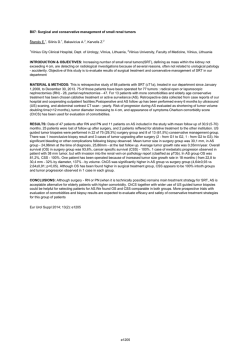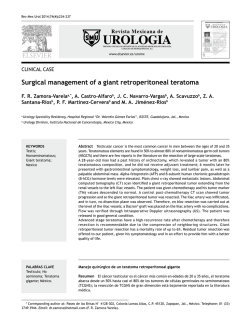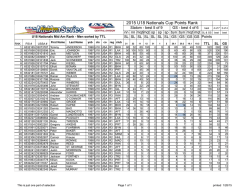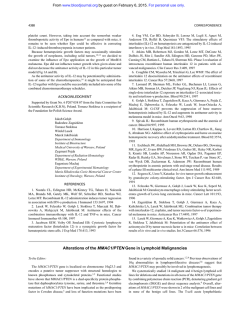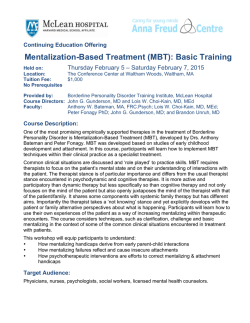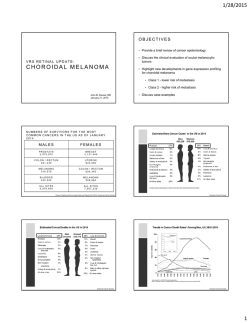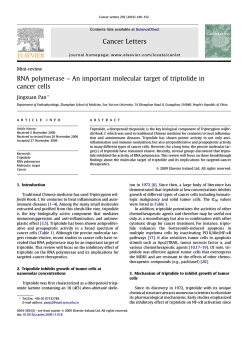
Is it Borderline Resectable?
Borderline Resectable Pancreatic Cancer: Charles M. Vollmer, Jr., MD Director of Pancreatic Surgery University of Pennsylvania St. John Providence GI Symposium Troy, MI February 28, 2015 I Have No Disclosures Except appreciation Borderline Resectable Pancreatic Cancer: We’ve Got Issues! Charles M. Vollmer, Jr., MD Director of Pancreatic Surgery University of Pennsylvania Society of Surgical Oncology Washington, DC March 7, 2013 A Cautionary Tale Just Last Week… Healthy 70 y.o. presents with vomiting and weight loss Inappropriate Care Over 2 weeks time… • CT, MRI, EUS with Biopsy • Definition of “Borderline Resectable PDAC • PICC with TPN • Staging Laparoscopy with US • PTC for Biliary Drainage • Port-a-Cath Placement • Plan for “Neoadjuvant” therapy ASAP. The Final Analysis • Whipple • Uncomplicated 7 day stay • Ampullary CA (Intestinal type) • Moderate Differentiation • Margin Negative • 0/27 Nodes Next Week… Healthy 73 y.o. presents with jaundice Today’s Journey • Conceptual framework. • The problems with definitions. • Is neoadjuvant therapy the breakthrough? • The state of the literature. • Quandarys Three Classes of Tumors Clearly Resectable Aaaah! Three Classes of Tumors Clearly Unresectable UGGH! Three Classes of Tumors Borderline Resectable Or is it Borderline Unresectable??? Hmmh??? The Essence of “Borderlines” “Borderline tumors are best conceptualized as: Those that involve the mesenteric vasculature to a limited extent. Those for which resection, while possible, would likely be compromised by positive surgical margins … in the absence of preoperative therapy.” Katz MHG et al, Ann Surg Oncol ; E-pub Feb 23, 2013 Borderline Resectability A True Original There’s nothing like it! So What Are Those Issues? Consider This Where are the borders??? What are the lines??? The Lexicon of Borderline Resectable PDAC First things first… Is it Borderline Resectable? Or Borderline Unresectable? The Lexicon of Borderline Resectable PDAC Next Things Next… What does Locally Advanced mean? The Parlance “Touching” “Involvement” “Irregularity” “Pinching” “Narrowed” “Flattening” “Shifted” “Invested” “Thrombosed” “Extension to” “Impingement” “Approach” “Infiltration” “Occluded” “Abutment” “Teardroped” “Engulfed” “Obstructing” “Invasion” “Interface” “Displacement” The Parlance “Touching” “Involvement” “Irregularity” “Pinching” “Narrowed” “Flattening” “Shifted” “Invested” “Thrombosed” “Extension to” “Impingement” “Approach” “Infiltration” “Occluded” “Abutment” “Teardroped” “Obstructing” “Invasion” “Engulfed” “Interface” “Displacement” Are these nouns or verbs? The Qualifiers “Normal ___” “Minimal ___” “Bi- vs. Uni-lateral ___” “Short vs. Long segment ___” “Outright ___” “Limited extent ___” “Marginally ___” “Partial ___” < 180○ > 180○ The Lexicon of Borderline Resectable PDAC The Distinctions Are Arteries Different than Veins? Borderline Resectable Patients MD Anderson Classification Three Categories: A.natomy - Borderline Tumors (1/2 cases) B.iology - Equivocal Staging C.ondition - Marginal Performance Status Katz MGH et al, JACS, 2008 Does this remind you of the story with Pancreatic Fistula? Does this remind you of the story with Pancreatic Fistula? Consensus anyone? Borderline Resectable The Evolution • Mauer/Buchler (1999) • NCCN (circa 2003, with updates) • MDACC (2006) – Ann Surg Onc • MDACC Modification (2008) – JACS • AHPBA/SSO/SSAT Consensus (2009) Ann Surg Onc More inclusive criteria Borderline Resectable Lesions--Criteria MDA 2006 (Type A) AHPBA/SSAT/ SSO 2009 NCCN 2012 Arterial Involvement: Abutment Celiac axis √ Abutment SMA √ √ √ √ √ √ √ √ √ √ Abutment or encasement of short segment CHA, typically at GDA Venous Involvement: Abutment SMV/PV with/without impingement Short segment occlusion of SMV, PV, or SMV/PV confluence if reconstructable ‘Abutment’ <180° ‘Encasement’ >180° √ Varadhachary, Ann Surg Onc, 2006 www.nccn.org, 2012 guidelines Callery, Ann Surg Onc 2009 More Ambiguity Radiographic Descriptions Ishikawa Classification Circa 1992 There are others… Tumor Grading Raptopolous CT Scale (BIDMC - Boston) Describes tumor relationships with vasculature 0 - 4 scale 0 - No involvement 1 – Touches, no deformity 2 – Deformity of one side of vessel 3 – Around up to 2/3 of perimeter 4 – Complete encasement Kent TS et al HPB 2010 Raptopolous Grade 0 SMV TUMOR P SMA IVC Ao No involvement of critical vasculature (PV, SMV, SMA/Celiac) Fat plane or normal pancreas between tumor and vessel Raptopolous Grade 1 P TUMOR SMV SMA IVC Ao Loss of fat plane between tumor and vessel with, or without, smooth displacement of vessel Raptopolous Grade 2 SMV P TUMOR SMA IVC Ao Flattening or slight irregularity of one side of the vessel Raptopolous Grade 3 P SMV TUMOR SMA IVC Ao Tumor extending around at least 2/3 vessel perimeter, altering its contour and narrowing the lumen Raptopolous Grade 4 PV TUMOR SMV P GE Occluded / obliterated vessel Why Is This Important? What is Borderline Resectability? Can this tumor come out? Will it be a harder operation? Will it come out completely? If it does….What survival can we expect? Unresectability by CT Grade 100 90 80 70 60 50 40 30 20 10 0 P<.0001 100% 82% 60% 29% 16% G0 G1 G2 G3 G4 Kent TS et al HPB 2010 + Margin Status 90 80 P=.04 83% 70 60 50 40 43% 30 20 25% 21% 10 0 G0 G1 G2 G3 Kent TS et al HPB 2010 Overall Survival by Grade Median survival (Overall 21 mos) Grade 0 Grade 1 Grade 2 Grade 3 Grade 4 P<.0001 27m 22m 17m 16m 9m Is Neoadjuvant The Answer? Neoadjuvant Treatment Potential Advantages Realizing it works in other solid malignancies… Consensus Statement Preoperative “Neoadjuvant” Therapy for Localized Operable Pancreas Cancer Provides a rational alternative to a “surgery-first” approach to resectable pancreas cancer Can be initiated for all eligible patients and successfully identifies a subset of patients for whom resection will not offer a survival benefit May improve negative-margin resection rates and decrease local failure rates Should be considered investigational but merits broader studies with multidisciplinary expertise Will be better defined with more standardized definitions, techniques, and grading systems Neoadjuvant Treatment Contrary Opinions • Biology of pancreatic cancer precludes any therapeutic effect (Stroma/Cell paucity) • Local/regional metastatic disease can be staged preoperatively in most cases without “waiting it out” (Laparoscopy) • Early declaration of metastatic disease is exceedingly rare (<10%) • Can’t be cured without the primary therapy (resection) • Positive margins may not matter as much… BIDMC Experience Cyberknife Radiotherapy Salvage of + Margins Cohort N Median Survival (Months) 2-Year Survival (Actuarial) 5-Year Survival (Actuarial) Overall 184 21 43% 23% Negative Margins (R0) 118 24 49% 25% Positive Margins (R1) 66 19 35% 22% Untreated 13 8.5 0% ChemoRT 28 19 49% ChemoRT+CK Boost 25 30.5 66% Neoadjuvant Treatment Other Disadvantages • Requires full multidisciplinary approach • Need for acquisition of a secure diagnosis • Chronic management of biliary obstruction • Initial staging of the tumor is unknown • Dropout of initially good surgical candidates • Patients want clarity…immediately Which Is Better? Here’s the data directly comparing the preoperative vs. postoperative adjuvant process in a rigorous manner… The Evidence Phase III-studies for Neoadjuvant therapy Borderline Resectable Tumors GroupStudy year Patients (n) Inclusion criteria Resection -Status Treatment arms Median overall survival (Months) p-value Preoperative Imaging Consensus Statement Approaches to Borderline Resectable Pancreas Cancer To facilitate comparison of future clinical trials, a standardized definition of borderline resectable pancreas cancer that uses objective CT criteria should be adopted. Patients in this category should be studied differently from those whose tumors meet such objective criteria for either resectability or unresectability. Patients in this category should be treated with neoadjuvant therapy, ideally in the context of a clinical trial. Abrams RA et al. Ann Surg Oncol 2009 Borderline Resectable What to do about these? Benefit to Neoadjuvant? Can they be down-staged radiographically? Can they be down-staged pathologically? Is it more (or less) cost effective than surgeryfirst? The Big Questions? Will Neoadjuvant therapy make some of these resectable when once they were not? Will it be worth it in terms of survival? The Literature on BRPC Is limited. Is dominated by NA reports. Is not pure…. polluted by data from locallyadvanced, unresectable cases. Conclusions From The Literature • Objective radiographic response is rare (<12%). • Borderlines with NA are more often LN and Margin – • Borderline survival is better when the tumor is surgically removed. • BRPC survival is equivalent to otherwise resectable tumors (if you can get it out!) • Unknown whether chemo alone or C-XRT is superior. • Don’t do this if you can’t perform vascular resections or don’t have suitable multidisciplinary care. • There are few comparisons of BRPC tumors with neoadjuvant therapy vs. surgery alone. NA Studies What’s Out There? 2 Meta-analyses show no survival benefit of NA for “Resectable” disease Single arm, Phase II studies show modest benefit for “Borderline Resectable” tumors NCCN: “Based on lower level evidence (Category 2B), there is NCCN consensus that the intervention is appropriate” Assifi MM, Surgery, 2011 Andriulli A, Ann Surg Onc, 2012 Are we really altering Biology? Or is this just improved selection? Tumor Markers What happens with CA 19.9 with neoadjuvant therapy of borderline tumors? CA 19-9 Change and Resection Status Association Between Change in CA 19-9 and Resection NPV=88% (Increase = No Resection) PPV=70% Pre- vs. Post-NT CA 19-9: Association with Metastases AUC=0.80 AUC=0.67 CA 19-9 Normalization and Survival Other “Issues” • What is an operable tumor after therapy? • The variable use of vascular reconstruction • Pathologic assessment of the specimen What is a positive margin??? • Quality Assurance in med- & rad-onc care Original Situation You decide not to operate 6 Months Later You Get What You Get <1% of these pictures will change with NA Katz MH, Cancer, 2012 If you didn’t like it then, why do you like it now? It’s a Crapshoot Axial Imaging Sensitivity = 60% Specificity =77% PPV = 49% NPV = 84% Porembka M, HPB, 2011 The Literature Vein Involvement During Pancreaticoduodenectomy: Is There a Need for Redefinition of “Borderline Resectable Disease”? Kaitlyn J. Kelly, Emily Winslow, David Kooby, Neha L. Lad, Alexander A. Parikh, Charles R. Scoggins, Syed Ahmad, Robert C. Martin, Shishir K. Maithel, H. J. Kim, Nipun B. Merchant, Clifford S. Cho, Sharon M. Weber J Gastrointest Surg (2013) 17:1209–1217 These data suggest that up-front surgical resection is an appropriate option, and call into question the inclusion of isolated vein involvement in the definition of “borderline resectable disease.” Early Progression NA therapy as a biologic “incubator” <5% occurrence within 6 months How can you rule out “early progression of disease” with NA when the regimens used are as short as 2 weeks long? My solution – Laparoscopic staging Actually rarely done in NA protocols This Stuff is Confusing Folks…Tell me: What drugs should I use? What modalities should I use? How “hot” should they be (XRT)? How long does it take? Patients want clarity? They fear Chemo… It Is… But It Isn’t If the purpose of NA is to guarantee the “complete” delivery of systemic therapy early…. Why do so many patients (up to 50%) get more after their surgery??? Alliance 021101 Borderline Resectable PDAC (Head) P R E R E G I S T E R Submit image for Central Review Induction Therapy R E G I S T E R Combined R ChemoRT E (1 cycle=14 Capecitabine S days) w/ RT every T mFOLFIRIN R day for 28 A OX for 4 days E G cycles S E T A N D R E S T A G E Surgery R E S T A G E A N D A N D R E S T R E S T Adjuvant Tx (1 cycle=28days) Gem d 1,8,15 for 2 cycles Parting Thought Counterpoint Intent to treat? How would the numbers look if we took all borderline resectable patients, went to surgery, resected those which can, and palliated unresectable patents surgically? Survival From Diagnosis Preoperative CRT Surgery First Borderline Resectability A True Original There’s nothing like it! Borderline Resectability A True Original There’s nothing like it! We’ve got our work cut out for us. Borderline Resectable Pancreatic Cancer: Definitions and Approaches Charles M. Vollmer, Jr., MD Director of Pancreatic Surgery University of Pennsylvania St. John Providence GI Symposium Troy, MI February 28, 2015 AHPBA/SSAT/SSO Definition A) Tumor abutment of the SMA not to exceed <180 Degrees of the circumference of the vessel wall. B) Segmental tumor involvement of the hepatic artery without extension into the celiac axis. C) Venous involvement of the SMV/portal vein demonstrating tumor abutment with or without impingement and narrowing of the lumen. D) Short segment venous occlusion resulting from either tumor thrombus or encasement but with suitable vessel proximal and distal to the area of vessel involvement.
© Copyright 2026
